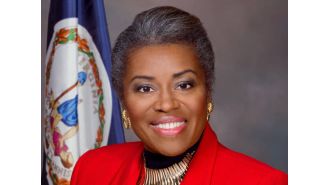These Cops are Supposed to Protect Rural Villages. They’re in the Suburbs Instead.
Many remote Alaska Native villages have no law enforcement at all. But state troopers can be found in wealthier, and mainly non-Native, suburbs, where growing communities have resisted paying for their own police department.

WASILLA, Alaska — The man appeared around dinnertime in the parking lot of the city Police Department, asking to see a cop. Another fight with his wife. Nothing violent, he said, but she threatened to carve a word in the paint of his luxury pickup: CHEATER.
Maybe an officer could go talk to her? A routine request on a routine night for the Police Department of this small suburban city, made famous by former Mayor Sarah Palin. (She lives up the road.)
But it wasn’t a city cop, paid by local sales taxes, who took the call. Instead, Alaska State Trooper Ryan Anderson hopped in his Ford Explorer. One of just 304 members of the elite, state-paid police force responsible for protecting all of Alaska, including remote towns and villages, Anderson motored 2 miles outside city limits to a subdivision of $400,000 houses.
The trooper never made it to the scene to hear the wife’s side of the story. As he steered past the parked RVs and snowmobile trailers, his radio chirped with new urgency. A housesitter outside the neighboring city of Palmer had just pulled a gun on a trespasser who was now on his knees, hollering for help.
Anderson punched the address into his screen, hit his siren and gunned the engine. Leaving the Wasilla city police headquarters behind, he soon entered Palmer and passed a second city Police Department equipped to respond to such emergencies, the red and blue flashers of his patrol car reflecting in windows like Christmas lights.
Because this emergency fell just outside of Palmer city limits, it too was considered a job for troopers, not city police. “I am the closest unit, and I’m 17 miles away,” Anderson said.
Nowhere in Alaska is the two-tiered justice system more evident than here in the fastest-growing region of the state. Many far-flung Native villages go unprotected while mostly wealthier, and mostly non-Native, communities on the road system receive the lion’s share of state-funded law enforcement.
Troopers like Anderson work for a state police agency created in 1953 to provide basic law enforcement in areas too small or too remote to employ local police. In addition to search and rescue missions, felony investigations and highway patrol, they also must protect any area where residents can’t or won’t pay for their own cops.
But what happens when one such community is also one of the most highly populated and easily accessible places in Alaska? Fifteen years ago, a blue-ribbon task force recommended the Matanuska-Susitna Borough adopt police powers and begin paying for its own law enforcement. It didn’t follow that advice. And since then, the population here has grown by 41%.
A similar scenario is playing out in other well-populated areas outside city limits, including on the outskirts of Fairbanks and on the Kenai Peninsula south of Anchorage. They, too, use troopers to respond to burglaries, domestic violence calls and other incidents that in other states would be handled by city police or county sheriffs.
With a limited number of troopers available statewide, those who stand to lose out are villages, many with predominantly Alaska Native populations that have no law enforcement of any kind. The Anchorage Daily News and ProPublica reported in May that 98 villages — communities with a total population of 30,000 — had no state-funded law enforcement at some point in 2019. (Of that number, about 70 communities had no local police of any kind, meaning no village city police officers or tribal officers.)
Residents in these communities sometimes have to wait hours, or even days, for a trooper to respond to an emergency. They report being forced to lock themselves in their homes or even having to tackle and duct-tape suspects until a trooper arrives. Victims of sexual assaults sometimes must avoid showering for a day or more until they can be flown by plane to a larger city for a sexual assault examination.
This, anthropologist Rosita Worl said, is what inequality looks like.
“We are citizens of the state of Alaska,” said Worl, who is from the Tlingit tribe and president of the Juneau-based Sealaska Heritage Institute. “We are entitled to the same services that the state provides other citizens.”
More than one in 10 trooper positions are vacant though funding exists for them. Struggling to fill jobs, the state increased trooper salaries and reported a spike in applicants in 2019. Gov. Mike Dunleavy told village delegates at the statewide Alaska Federation of Natives convention in October that the agency expected to place troopers in additional villages in “the coming year.”
For now, the Mat-Su, with a population of 105,743, is home to one in seven Alaskans but more than one in five troopers. (That includes regular troopers, recruits, wildlife troopers who focus on enforcing hunting and fishing laws and sergeants who aid in investigations.)
Many rural areas in Alaska also receive more than their share of troopers to cover their small populations. But what makes the Mat-Su different is that it is almost entirely reachable on the road system. As much as 80% of the state is not.
Currently, most rural troopers work in regional cities on a “hub and spoke” model, flying to outlying villages as needed. Sour weather often delays or prevents travel, however, and as of Sept. 30, troopers were posted directly within 11 of about 170 small villages.
The Mat-Su may be in line for even more troopers, potentially compounding the problems elsewhere. Emails obtained through public records requests show the Dunleavy administration invited the manager of the Mat-Su Borough to discuss a plan that would add troopers to the region.
As described by Dunleavy’s deputy chief of staff, the state would subsidize half of the cost of each additional trooper. A spokesman said that the idea was one of many discussed and that the cost-splitting approach was first proposed by Mat-Su officials. The governor’s team also spoke with leaders in the Northwest Arctic Borough about forming new public safety partnerships there, the spokesman said.
Dunleavy lives in the Mat-Su and represented the region in the state Legislature. He has repeatedly refused interviews on public safety and other topics this year. State public safety officials dispute that suburban troopers come at the expense of villages; Alaska Native leaders say the proof is in the numbers.
Col. Barry Wilson, head of the troopers, said the situation in the Mat-Su Borough is not unlike what happened decades ago on the outskirts of Anchorage before the city absorbed outlying neighborhoods and began providing local police coverage.
“We continue to do the job until they do,” Wilson said, emphasizing that troopers are meant to be a rural police force. The Mat-Su population is expected to continue as the fastest growing in Alaska, increasing 58% by 2045, according to state labor projections.
“I’m hoping not to be doing all law enforcement in the Mat-Su Valley,” he said. “When (they) have an Anchorage-sized community, they should have their own law enforcement agencies.”
Long before Alaska became a state, the U.S. Army and Navy provided basic law enforcement in the frontier while tribes practiced traditional forms of justice, from community talking circles to banishing wrongdoers from their home villages — a potential death sentence in the cold black of winter.
As the population grew with highways and military bases, the Legislature established territorial police, later renamed state police and finally evolving into the current trooper agency in 1967. That year, Public Safety Commissioner Mel Personett told the officers to focus on areas without local police.
The state is so big — nearly a fifth of the country — and so wild that it’s hard to say what constitutes a “rural” community. Certainly isolated island villages fit the label. So too do homesteads deep in the Mat-Su, which are accessible by road but could take a trooper hours to reach.
The trickier question: Who should pay to police highly populated neighborhoods right on the edge of cities? In the mid-1980s, members of the Legislature sought to force affluent Anchorage and Juneau neighborhoods to begin paying for their own police instead of relying on trooper coverage.
“The state troopers, in my view, were never set up for municipal patrols,” then-Public Safety Commissioner Robert Sundberg said at the time. Juneau and Anchorage eventually expanded coverage.
The notion that the Mat-Su ought to do the same is nothing new. As the population mushroomed by 4% to 5% each year in the early 2000s, the borough mayor called for a study of police powers. But, after the 2005 report) concluding that the borough should ask for the authority to adopt police powers, borough Assembly members immediately shelved the idea. They worried the Mat-Su would lose the state-funded trooper presence if the borough took on policing authority, the Daily News reported at the time.
“I just think the cost was too much,” said Lynne Woods, who served on the Assembly from 2004 to 2010. It was difficult enough to find money to build schools fast enough for all the new families.
Today, 86% of residents in the Mat-Su live in subdivisions and neighborhoods outside the city limits of Wasilla and Palmer. These homeowners generally pay property taxes for fire protection and snowplowing but not for police. (The Mat-Su has a median household income that is nearly twice that of the Yukon-Koyukuk Census Area, where five troopers serve 26 Alaska Native villages and towns.)
Outraged by rising property crime and drug abuse in the borough, Mat-Su residents in 2018 voted to allow a task force to once again consider adopting police powers. But some of the members have gone on record saying a boroughwide police department of 100-plus officers would be too expensive. Whatever they propose, they do not want any Mat-Su troopers to be redeployed elsewhere in Alaska.
If the borough starts paying for its own cops and trooper call volumes subsequently drop, Wasilla Police Chief Gene Belden told the group, the troopers will move to an area without coverage.
His siren blaring, Trooper Anderson’s SUV raced from the Wasilla subdivisions to the gun call outside of Palmer.
Other cars pulled to the side of the road as he rocketed away from the strip malls and gas stations of one set of city limits, merging onto the four-lane highway, switching to another highway, flashing past Matanuska Lake and Kepler Lake and Echo Lake, all covered in eggshell ice, steering next into the heart of Palmer with its vintage storefronts and out again, down along the Matanuska River and, finally, into a rough-edged neighborhood known as the Butte.
Troopers in the Mat-Su work 12-hour shifts, and only about five or six are on the road at any given time. A wall-sized map at their Palmer headquarters shows the 20,000-square-mile area they must cover on a daily basis. It’s the size of West Virginia, stretching from the Alaska Range to the Canadian border.
By comparison, the Wasilla and Palmer police departments are responsible for about 20 square miles combined.
While most emergency calls are made within the smaller core area circling these two cities, Anderson said he’s put hundreds of miles on the odometer of his Ford Explorer in a single day, crisscrossing the valley.
Anderson pulled to a stop at wooded intersection, the full moon illuminating pale birch trees and distant snowcaps. It had been a busy night here. A few hours earlier, another trooper arrived to arrest a woman who stole a brownie at the neighborhood liquor store.
“It’s calls like this that are petty in nature and end up sucking so much time,” Anderson said of the shoplifter.
He stepped out of his car and chatted with a Palmer police officer. The address Anderson was headed for is outside Palmer city borders, but because a gun had been drawn, the city cop also responded to provide backup. He already had the would-be burglar in cuffs.
Anderson strode across the street. A man in a camouflage jacket and Santa beard, his handgun safely tucked away in a pocket, said he was housesitting when he spotted someone trying to break in.
“I said: ‘Freeze, put your hands in the air or I’ll blow your damn head off. And get on your knees,’” the man recounted to Anderson.
Back at the patrol car, the man in custody, four-times too drunk to drive and outraged at being cuffed, blurted he had indeed been trespassing. But he wasn’t trying to burglarize anybody, he said. Just taking a shortcut.
“You guys are horrible,” he told the trooper. A crowd had gathered, drawn by the flashing lights.
Anderson, tall and friendly, grew up in California and applied to become a trooper after seeing a reality show about the agency on National Geographic. He let the man smoke a cigarette to the filter before booking him into jail. By the time he finished his smoke, the suspect declared Anderson one of his favorite troopers.
Returning to Palmer and the trooper headquarters, Anderson walked below a handmade wooden sign that reads, “I intend to go in harm’s way.” It was nearing midnight; the evidence room, lockers and laboratory dark and silent. He sat at his desk to finish paperwork on the Butte trespasser.
Over the past 12 months, Alaska state troopers responded to thousands of calls for service in the mostly suburban area core of the Mat-Su, including a triple homicide discovered 6 miles outside Wasilla.
Burglars, he said, know city police generally respond faster to calls than troopers can and adjust their plans accordingly. Recently, a man known for trying to break into parked cars learned that if he worked neighborhoods outside city limits, he was more likely to avoid capture.
“Most criminals know where that line is,” he said.
The redeployment of troopers to suburban areas is not happening in a vacuum. A tier of state-funded officers intended to augment emergency response in rural areas is on the brink of failure, as the Daily News and ProPublica reported in October. The number of village public safety officers, who are paid for with state of Alaska grants, is at an all-time low.
In 1999, many Alaska tribes filed a lawsuit against the state, seeking to have the lack of village police declared racist and unconstitutional. The attempt failed at the Alaska Supreme Court, and today the definition of “rural” and the fight over which institutions are responsible for protecting Alaskans is no closer to being resolved.
And so, many villages must wait for first responders.
When a man was found bleeding from a gunshot wound on the steps of his brother’s home Oct. 20 in the Bering Sea village of Scammon Bay, for example, bad weather stopped troopers and a medevac flight from landing until the next day. By that time the man had died.
Worl, the anthropologist who is also a former director for Sealaska Corp., a for-profit Native corporation that serves residents in Southeast Alaska, said distribution of state troopers reminds her of the early days of public education in Alaska.
The government built schoolhouses for small, mostly white towns, she said, while students in Alaska Native villages were shipped to boarding schools. (The Mat-Su Borough is 83% white. By comparison, 78% of Alaska communities that have a school but no local police presence are predominantly Alaska Native.)
While Alaska Natives are members of federally recognized tribes, that doesn’t absolve the state’s responsibility to provide basic services in remote Native communities, Worl said.
When talk of inequity in public services arises in Alaska, residents sometimes question why Alaska Native corporations, created under the Alaska Native Claims Settlement Act, don’t pay for more services in shareholder villages.
Some regional corporations did not respond to requests to address that question. Others said they fund a variety of social service and cultural programs across Alaska but were not created to subsidize government services.
“While the solution to Alaska’s public safety crisis is complicated, your question is not,” wrote Megan Moore, spokeswoman for Kotzebue-based NANA Corp., which represents more than 14,300 mostly Inupiat shareholders. “It is neither the role nor the responsibility of Alaska Native regional corporations to provide law enforcement in rural Alaska.”
Far removed from communities that go without running water or police of any kind, the Mat-Su feels lawless and underserved by law enforcement to many who live there. While there are more troopers here overall than any other area of Alaska, a university study concluded they are overworked and the region needs 26 more law enforcement officers to meet demand fueled by the ever-rising population. (No such study has been completed for any other region of the state.)
The question facing the Mat-Su, and Alaska, is whether those added officers should be state-funded troopers or locally funded police. Hiring cops through more property taxes alone would be a hard sell. Anderson now lives in the Mat-Su and can’t imagine how the borough could ever afford to create its own police force. “I pay an outrageously high property tax rate,” he said.
A review of property tax rolls shows Anderson pays a rate of $1,603 per $100,000 in home value, slightly below the average Anchorage rate of $1,636 per $100,000 in home value.
The trooper said that if he lived in Wasilla, the amount would be lower because that city has a sales tax that reaps revenue from big box stores where much of the Valley shops. The borough itself has no sales tax, and the Assembly in August killed the most recent attempt to create one. The state of Alaska also has no income tax and no sales tax.
Under these constraints, the new Mat-Su task force has been meeting since March to weigh several potential ideas for adding police to the borough.
All proposals would require voters to hand police power to the borough — a steep ask in the deeply conservative Valley, which generally rejects any proposal to expand government powers. If the Mat-Su Borough launched a full-service police department, the cost measured in property tax on a $300,000 home could be $1,200 to $1,500 a year.
“Nobody is going to vote for that,” said Assistant Borough Manager George Hays, who expects the task force to present a boroughwide police force as the last option on its list of recommendations, if it presents it all.
The members are learning toward the creation of a 20-officer special task force that would add investigators — but not so many officers that troopers would be able to leave.
Meantime, the presence of so many troopers in the Mat-Su hasn’t escaped the notice of other local governments. When the state approached the city and borough of Haines in 2017 and suggested the small Southeast Alaska community expand its Police Department so the local trooper could relocate to Bethel, borough officials said no way. Not when the Mat-Su wasn’t being asked to do the same on a larger scale.
“We didn’t think it was right that they would ask us to do what they wouldn’t ask the Mat-Su Borough to do,” Haines Borough Manager Debra Schnabel said.
One idea under consideration, said Mat-Su police task force member Jim Sykes, is to create a borough police service area that includes all homes within a 20-minute drive of Palmer and Wasilla. Another proposal would have the borough pay the police departments of those cities to extend their coverage areas. Troopers already use the same dispatch center as Wasilla police, and the city officers and troopers regularly provide backup for one another.
The city cops are also less expensive. Troopers start out at $72,768 a year, and some longtimers pull down more than twice that. Wasilla police start at $53,394 a year.
Mat-Su Assemblyman Jesse Sumner, who first suggested the state and borough meet to discuss splitting trooper costs, said he would oppose relocating troopers to rural Alaska. Asked if Mat-Su residents should pay for the police services that troopers provide, Sumner replied, “Sure.”
“But we’re not going to do that, as long as we don’t have to,” he said.






